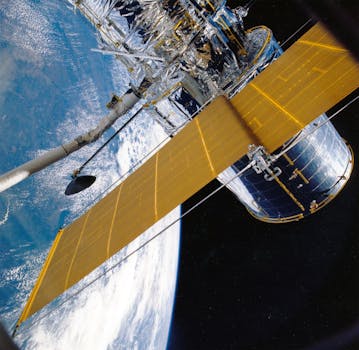Orbiting Innovations: Key Updates in Satellite Telecommunications Technology
The latest advancements in satellite telecommunications technology are transforming the way we communicate and access information. This article explores the key updates and innovations in the field, including advancements in satellite design, launch technology, and telecommunications services.

Orbiting Innovations: Key Updates in Satellite Telecommunications Technology
Orbiting Innovations: Key Updates in Satellite Telecommunications Technology is a rapidly evolving field that has revolutionized the way we communicate and access information. With the increasing demand for global connectivity and the need for reliable and efficient telecommunications services, satellite technology has become a crucial component of modern communication systems. In this article, we will explore the key updates and innovations in satellite telecommunications technology, including advancements in satellite design, launch technology, and telecommunications services.
Satellite telecommunications technology has come a long way since the launch of the first commercial communications satellite, Intelsat 1, in 1965. Today, there are thousands of satellites orbiting the Earth, providing a wide range of telecommunications services, including television broadcasting, internet connectivity, and mobile communications. The latest advancements in satellite technology have enabled the development of more efficient and cost-effective satellites, with improved performance and capabilities.
Advances in Satellite Design
One of the key areas of innovation in satellite telecommunications technology is in the design of satellites themselves. Modern satellites are designed to be more efficient, reliable, and cost-effective, with improved performance and capabilities. Advances in materials science and manufacturing technology have enabled the development of lighter and more robust satellites, with improved thermal management and radiation protection. Additionally, the use of advanced propulsion systems, such as electric propulsion, has enabled satellites to operate for longer periods of time and to maneuver more efficiently in orbit.
Another area of innovation in satellite design is in the development of smaller and more agile satellites, such as CubeSats and SmallSats. These satellites are designed to be launched at a lower cost and to provide more targeted and flexible telecommunications services. They are often used for applications such as Earth observation, communications, and navigation, and have enabled the development of new and innovative telecommunications services.
Launch Technology Advancements
Launch technology is another area of innovation in satellite telecommunications, with the development of more efficient and cost-effective launch systems. The use of reusable launch vehicles, such as the SpaceX Falcon 9 and the Blue Origin New Glenn, has significantly reduced the cost of launching satellites into orbit. Additionally, the development of new launch vehicles, such as the Ariane 6 and the Vulcan Centaur, has enabled the launch of heavier and more complex satellites, with improved performance and capabilities.
The development of new launch sites and facilities has also played a crucial role in the advancement of satellite telecommunications technology. The construction of new launch sites, such as the SpaceX Starbase in Texas and the Blue Origin launch site in Florida, has enabled the launch of satellites from a wider range of locations, and has reduced the cost and complexity of launch operations.
Telecommunications Services Innovations
The latest advancements in satellite telecommunications technology have also enabled the development of new and innovative telecommunications services. The use of high-throughput satellites (HTS) has enabled the provision of high-speed internet services, with speeds of up to 100 Gbps. Additionally, the development of low-Earth orbit (LEO) constellations, such as the OneWeb and Starlink systems, has enabled the provision of global communications services, with low latency and high availability.
The development of new telecommunications services, such as 5G and IoT (Internet of Things), has also driven innovation in satellite telecommunications technology. The use of satellite-based 5G services has enabled the provision of high-speed and low-latency communications services, with applications in areas such as autonomous vehicles, smart cities, and industrial automation. Additionally, the use of satellite-based IoT services has enabled the provision of remote monitoring and control services, with applications in areas such as agriculture, transportation, and energy management.
Conclusion
In conclusion, the latest advancements in satellite telecommunications technology have transformed the way we communicate and access information. The development of more efficient and cost-effective satellites, launch technology, and telecommunications services has enabled the provision of global connectivity and reliable telecommunications services. As the demand for satellite-based telecommunications services continues to grow, we can expect to see further innovations and advancements in the field, with new and exciting applications in areas such as 5G, IoT, and beyond.






